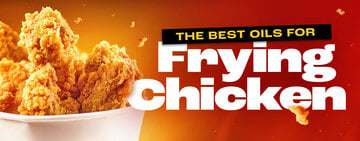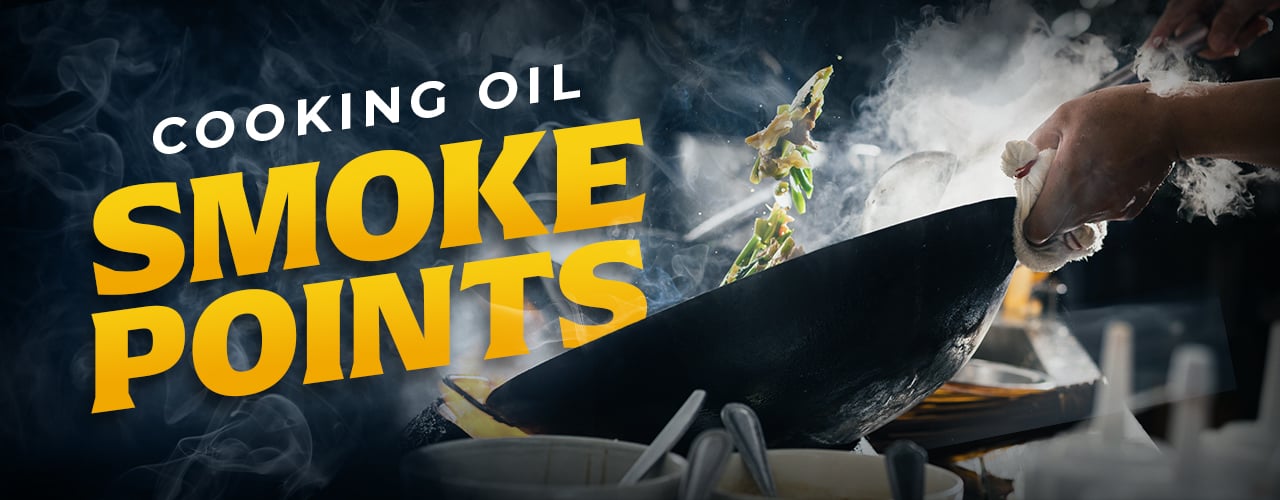
Cooking Oil Smoke Points
Last updated on 3/13/2023While we associate sesame oil with Asian dishes and olive oil with Mediterranean food, the flavor profile is just one element of choosing cooking oil. Equally, if not more important, is selecting an oil that will not break down or burn during your cooking process. Cooking oils smoke and burn at different temperatures based on their monosaturated fat levels and their refinement process. Choosing an oil with an appropriate smoke point is both a fire prevention and food safety measure. We break down the smoke points of popular cooking oils so you can protect your customers and staff from toxins and burns.
Shop All Cooking OilWhat Is Smoke Point?
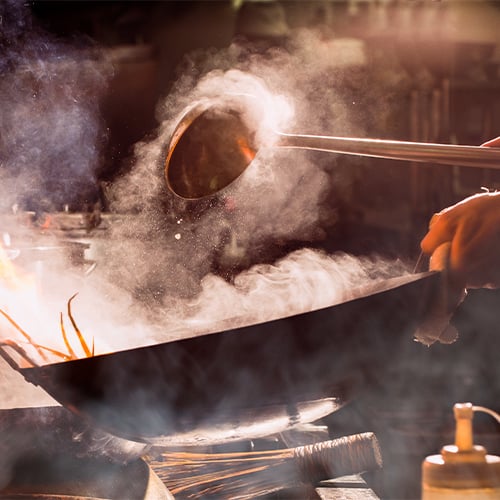
Smoke point is when cooking fat reaches its burning point. When fats like lard, oil, or butter smoke, it means they’re breaking down and releasing chemicals. This imbues your food with burnt flavors and releases free radicals. Free radicals are unstable atoms that can damage cells. Even if they don't become toxic, cooking fats lose their beneficial nutrients and phytochemicals when they reach their smoke point.
Each type of cooking oil has a unique smoke point, with some burning at temperatures beneath 250 degrees Fahrenheit and others withstanding temperatures over 500 degrees. In most cases, refined oils have higher smoke points. Refined oils that withstand extreme heat are high in monosaturated fat (i.e. high oleic). Unrefined oils contain a lot of minerals and enzymes that don’t interact well with high temperatures. Oils high in polyunsaturated fats are less stable and are unsuited for high-heat cooking methods like deep frying.
Oil Smoke Points
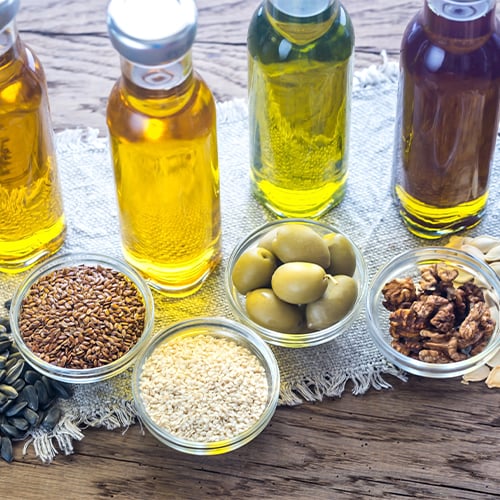
To find the right oil for your application, check out popular cooking oil smoke points below. We categorized oils by their smoke point range, so you can find the right oil for high heat, medium heat, low heat, and no heat cooking methods.
Best High Smoke Point Oils
Oils with smoke points over 400 degrees Fahrenheit are best for high-heat cooking applications. If you're frying, stir-frying, or broiling food, use one of the following cooking oils.
- Light Refined Olive Oil - The smoke point for light refined olive oil is between 390 and 479 degrees Fahrenheit.
- Refined Avocado Oil - The smoke point of refined avocado oil is between 480 to 520 degrees Fahrenheit.
- Canola Oil - All canola oil is refined and has a smoke point between 400 and 475 degrees Fahrenheit.
- Grapeseed Oil - Grapeseed oil has a high smoke point of 420 degrees Fahrenheit.
- Refined Peanut Oil - Refined peanut oil has a smoke point of 450 degrees Fahrenheit.
- Refined Sesame Oil - Refined sesame oil has a smoke point of 410 degrees Fahrenheit.
- Refined Sunflower Oil - Refined sunflower oil has a smoke point of 450 degrees Fahrenheit.
- Corn Oil - Corn oil has a smoke point between 400 and 450 degrees Fahrenheit.
- Soybean Oil - Soybean oil has a smoke point of 450 degrees Fahrenheit.
- Safflower Oil - Extremely well adapted to high heat, safflower has a smoke point between 475 and 500 degrees Fahrenheit.
- Macadamia Oil - Macadamia oil has a smoke point of 413 degrees Fahrenheit.
Best Medium Smoke Point Oils
Oils with smoke points between 350 and 425 degrees Fahrenheit are best for medium-heat cooking applications. If you're baking, sauteing, or browning food, use one of the following cooking oils.
- Unrefined Avocado Oil - The smoke point of unrefined avocado oil is between 350 and 400 degrees Fahrenheit.
- Vegetable Oil - Made from a blend of plant-extracted oils, vegetable oil has a smoke point of approximately 400 degrees Fahrenheit depending on the oils included.
- Refined Coconut Oil - Refined coconut oil has a smoke point of 400 degrees Fahrenheit.
- Lard - Lard has a smoke point of 374 degrees Fahrenheit.
Best Low Smoke Point Oils
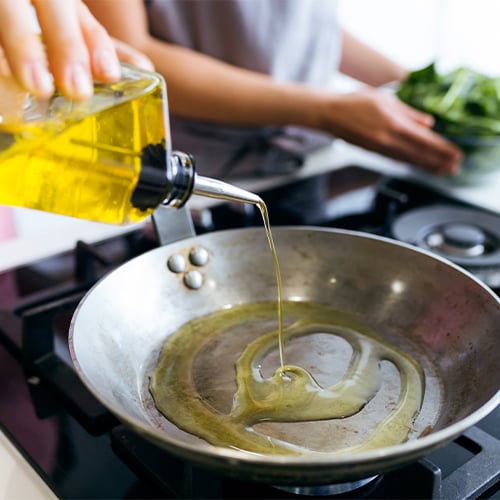
Oils with smoke points between 300 and 350 degrees Fahrenheit are best for low-heat cooking applications. Use one of the following cooking oils to gently saute or sweat your foods.
- Extra Virgin Olive - The smoke point for extra virgin olive oil is 320 degrees Fahrenheit.
- Unrefined Sesame Oil - Unrefined sesame oil has a smoke point of 350 degrees Fahrenheit.
- Unrefined Coconut Oil - Unrefined coconut oil has a smoke point of 350 degrees Fahrenheit.
- Unrefined Peanut Oil - Unrefined peanut oil has a smoke point of 350 degrees Fahrenheit.
- Unrefined Sunflower Oil - Unrefined sunflower oil has a smoke point of 320 degrees Fahrenheit.
- Butter - The natural smoke point of butter is between 302 and 350 degrees Fahrenheit.
Best No Heat Oils
Oils with smoke points in the 200 degrees Fahrenheit range are best suited to no heat cooking applications. Use the following oils as salad oils or as garnishes for plating presentations.
- Flaxseed Oil - Flaxseed oil has a low smoke point of 225 degrees Fahrenheit.
- Almond Oil - Unrefined almond oil has a smoke point of 225 degrees Fahrenheit and refined almond oil has a smoke point of 430 degrees Fahrenheit.
High Smoke Point Oil Chart
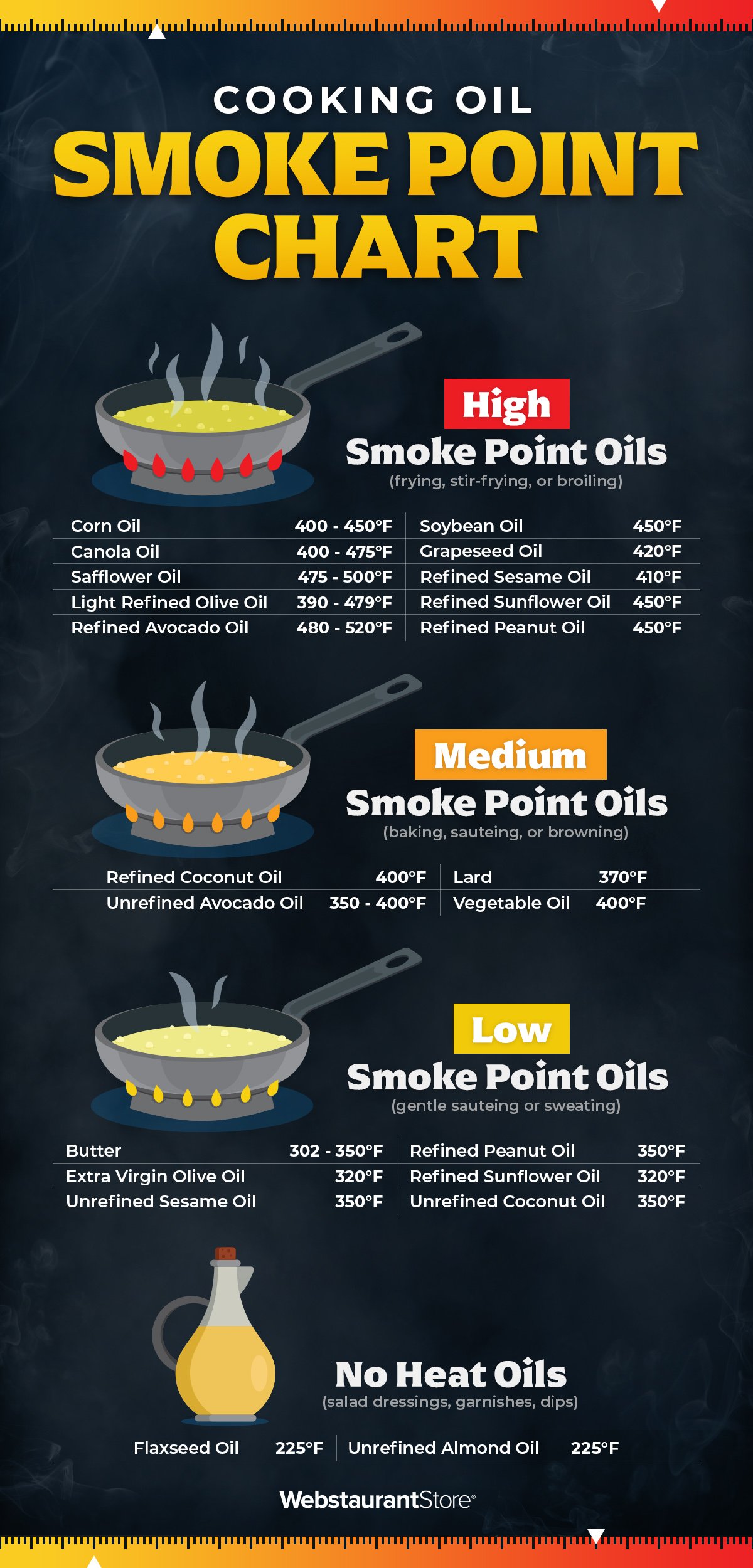
Cooking Oil FAQ
We answer some frequently asked questions about cooking oil so you can choose the best oil for your application.
What’s the Best Oil for Cooking?
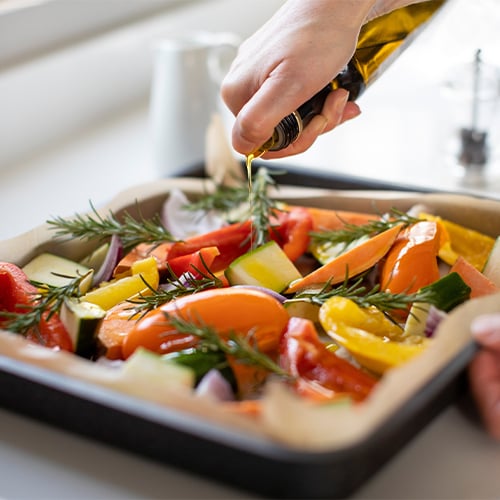
Oils with smoke points over 450 degrees Fahrenheit are safest for frying, stir-frying, and broiling applications. Select oils with smoke points around 400 degrees Fahrenheit for baking and browning foods. If lightly sauteing your foods, you can select cooking oils with smoke points in the 300 degrees Fahrenheit range. Only use low-heat oils with smoke points around 225 degrees Fahrenheit, like unrefined almond and flaxseed oil, as salad oil or make artful designs with them for trendy plating presentations. Oils with a high smoke point include peanut oil, canola, oil, sunflower oil, and sesame oil, making them some of the best oils for cooking.
Healthiest Cooking Oil
Olive oil, coconut oil, and avocado oil are the healthiest cooking oils. Olive oil is primarily made of a monounsaturated fat known as oleic acid, which boasts anticancer and anti-inflammatory properties. It also contains vitamin E and the antioxidant compounds oleocanthal and oleuropein. Coconut oil contains lauric acid, a medium-chain saturated fat that boosts good HDL cholesterol levels and may reduce the risks of heart disease. It also contains healthy phytochemicals and antioxidants. Avocado oil contains high percentages of oleic acid. Animal studies suggest avocado oil may help reduce blood pressure, lower LDL cholesterol, relieve joint inflammation, protect cells against free radical damage, and help your body absorb other nutrients.
Oils with High Smoke Point
In general, refined oils have higher smoke points than their unrefined counterparts. Specifically, avocado, peanut, canola, sunflower, and sesame oils have high smoke points.
What Oil Has the Highest Smoke Point?
Ranging from 510 to 520 degrees Fahrenheit, avocado oil has the highest smoke point of plant-based cooking oils. It’s made from fresh avocado pulp and contains over 50% monounsaturated fat which is less prone to oxidation.
Neutral Oil with High Smoke Point?
Avocado oil is a neutral-tasting oil with a high smoke point. Vegetable oil is another great neutral oil with a high smoke point. Light refined olive oil has a neutral flavor and a smoke point of approximately 465 degrees Fahrenheit, unlike extra virgin olive oil, which offers a robust flavor and a low smoke point of 350 degrees Fahrenheit.
Refined Oils vs Unrefined
Refined oils are more processed than unrefined oils and have higher smoke points. Manufacturers use heat to extract refined oils, which makes the process go faster and yields more oil. The downside of heat extraction is it reduces the oils' natural nutrients, aroma, and flavor. What remains is then stripped away through chemical treatments and a deodorizing and bleaching process. In contrast, unrefined oils are extracted through pressure rather than heat. They are also known as cold-pressed oils, a technique that retains most of their natural nutrients, aroma, and flavor.
Whether you’re roasting, sauteing, or deep frying, you must work with an oil that can tolerate the heat of your chosen cooking method. Reference back to our cooking oil smoke points guide any time you’re creating a new recipe and aren’t sure which oil is appropriate. If you’re out of your usual oil and want to try swapping it out for another one you have on hand, check its smoke point before using it.



